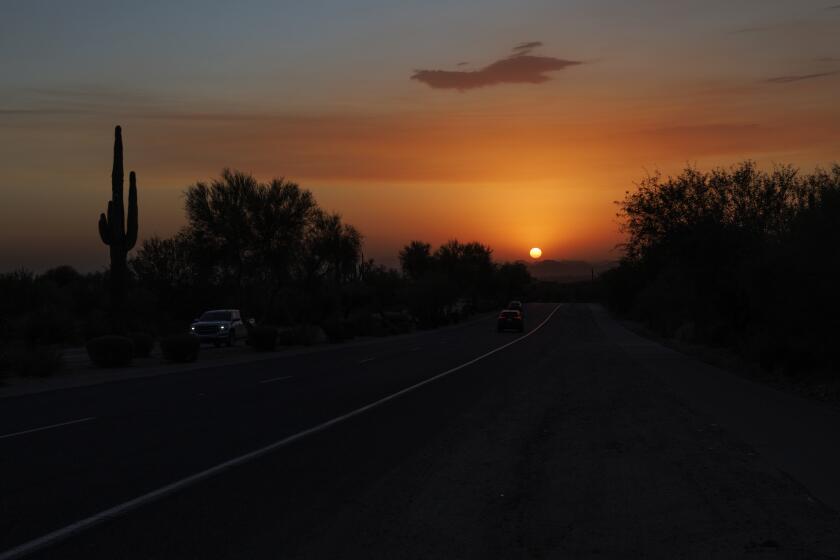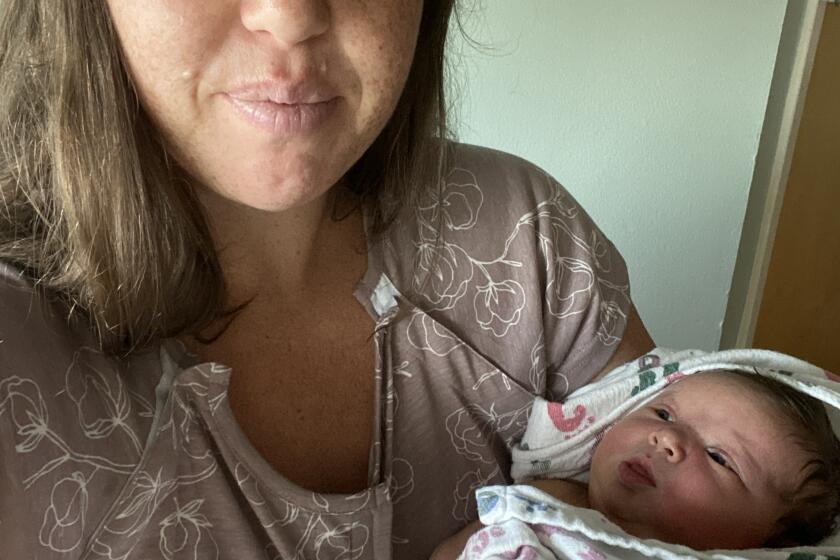Close to Danger
Sure, says Carmen, it’s a shock the first time your boyfriend hits you.
Even more shocking, says the Westminster High School senior, is the “pathetic way I handled it.”
Carmen recalls a face in the bathroom mirror the next morning that she hopes will never stare back at her again.
“I didn’t think it made a bruise when he did it,” says Carmen, now 17, twisting her long brown hair around her fingers.
“But even when it was covered with makeup, I could still see it on my cheek. . . . It took forever to go away, turning this ugly green color.”
Carmen isn’t the only teenage girl waiting for an ugly bruise to fade from her face--or from her memory.
Experts estimate that one in three high school students will experience violence in a dating relationship.
In one study of battered women who had sought shelter, more than half said they had been physically abused by someone they had dated.
“A lot of victims tell us that they experienced violent relationships in high school and as far back as middle school,” says Orange County Deputy Dist. Atty. Mary Meloch, who works in the family-violence unit. “We’re making a lot of headway as far as successful prosecution, but by the time they get here, it’s too late.”
While it may be too late for some in the turbulent cycle of violence, those close to the issue are trying to educate potential victims and batterers before they enter the court system.
In their quest to break the cycle, groups in Orange County and throughout the nation are bringing programs and support directly to teenagers on high school and middle-school campuses. Says one expert: “These guys don’t wait until their 21st birthday to smack their girlfriends around. It starts way before that.”
*
“When we first started this, we went just to high schools,” says Shirley Gellatly, community education director for Human Options, an Orange County center providing comprehensive services for abused women and children since 1984.
“Now we’re really building the middle-school program because the need is there.”
“The [number of] cases of young victims and older men is on the rise,” says Trish Levine, who teaches a teen-parent program through the Santa Ana Unified School District. “Our mantra is that love isn’t supposed to hurt.”
Although it is gaining recognition in the domestic-violence-prevention community, violence in teenage relationships remains largely undiscussed.
“I think there are a lot of teenage girls being pushed around and punched around; they just don’t tell anyone,” says Orange Police Det. Mike Harper. “They may tell a friend but not the police or their parents.”
According to the National Resource Center on Domestic Violence, the majority of teens in abusive relationships have not talked to any adult about the violence in their lives.
Typically, the abusive relationship involves a younger girl and an older guy. The relationship often turns passionate quickly and is marked by attempts to control, fits of jealousy and violent outbursts followed by gushing apologies.
Harper says that is the pattern that preceded the deaths almost three years ago of 19-year-old Megan Whalley of Orange and her 13-month-old son at the hands of her boyfriend, Danny Eugene Stewart.
More recently, dating violence is believed to have preceded the Oct. 22 shooting death of honor student Catherine Tran on the John Glenn High School campus in Norwalk.
*
Abusive behavior begins early, so early that domestic violence experts are now addressing the problem with younger audiences than before.
“In the adolescent years, the potential for relationship violence begins as dating relationships form,” says Meredith Blake of Break the Cycle, a prevention and intervention program targeting teens in the Los Angeles area. “We found that the earlier the education, the better chance you have of combating the problem.”
Identifying abuse can be tricky when talking to teens, says Meloch, who regularly speaks to high school students about the dangers of relationship violence.
Misconceptions about what defines relationship abuse are staggering, she says.
“There was one time when a girl raised her hand in class and asked, ‘If your boyfriend grabs your hair and yanks it [and] then slaps you on the side of the face, is that abuse?’ ” Meloch recalls.
Meloch confirmed for everyone in the audience that such behavior is indeed abuse and punishable by law.
The penalty for domestic-violence crimes ranges from mandatory diversion programs for the batterer to long prison terms.
“The cases that concern us the most are the victims who either say ‘I still love him’ after the initial report or claim [the abuse] never happened,” Orange County Superior Court Judge David Carter says. “This not only makes the victim sound at fault, but the abuser is also almost receiving a positive message, like, ‘Hey, I got away with it.’ ”
Some abusers are adept at delivering blows that are not obvious, Carter says.
“The abuser either hits them in the stomach or in a way that doesn’t leave a mark,” Carter says.
*
Stomach punches are still a painful memory for Heather, 20, of Lake Forest, who has used her experience to warn others through the Human Options program.
At first, Heather says, she thought he was “cute” and “easy to talk to.” Within five months of dating, her 16-year-old classmate had become an abusive, jealous and controlling boyfriend who said he’d kill himself if she broke up with him.
“He would show up on my doorstep crying. . . . I took him back time and time again,” Heather says.
She obtained a restraining order after being stalked and threatened.
Her message:
“There are so many things that play into it, but girls going through this need to understand that he has brainwashed you. Sooner or later, he’ll kill you.”
Experts say the same emotional response that keeps a woman married to an abusive spouse binds teen victims experiencing relationship violence.
Clinging to the “honeymoon period” of promises, gifts and tearful apologies, many young girls not only stay in relationships with their abusive boyfriends but often also do their best to cover up violent incidents.
“In a sick way, I guess I kind of liked the times that he would hit me, and it didn’t hurt that bad,” admits Carmen, the Westminster senior.
“Afterward, he was always really nice, you know? For a day or two, it was almost as good as it was at the beginning,” she says.
“I wasn’t even scared of him,” remembers the 17-year-old after six months of counseling. “I was more scared that my mom would find out and make me stop seeing him. . . . How sick is that?”
(BEGIN TEXT OF INFOBOX / INFOGRAPHIC)
WARNING SIGNS OF AN ABUSIVE RELATIONSHIP
* Things get really serious from the start. He seems like Prince Charming. Tells you he can’t live without you.
* He wants to spend all his time with you. Wants you to cut back on the time you spend with your friends or family because it comes between the two of you.
* You become hostile or secretive toward your parents. Find yourself apologizing for his behavior when he treats you badly.
* He starts trying to tell you how to dress, how much makeup to wear, etc. Wants you to wear something of his or something he gave you, then gets angry if you don’t always have it with you.
* He accuses you of flirting every time you’re around other guys. Starts thinking you’re cheating on him.
* Mood swings. One minute he’s angry and threatens or hurts you, and the next minute he’s the sweetest guy in the world who professes his undying love while showering you with gifts or affection.
* You’re afraid to say no to sex.
* His temper frightens you. You’re afraid to disagree with him. He throws things, breaks things, yells, holds you down, threatens to harm you or himself.
Source: Break the Cycle
More to Read
Sign up for Essential California
The most important California stories and recommendations in your inbox every morning.
You may occasionally receive promotional content from the Los Angeles Times.










